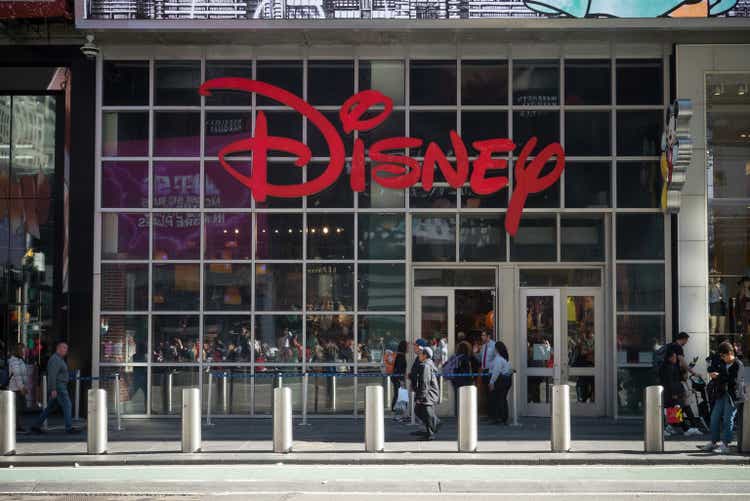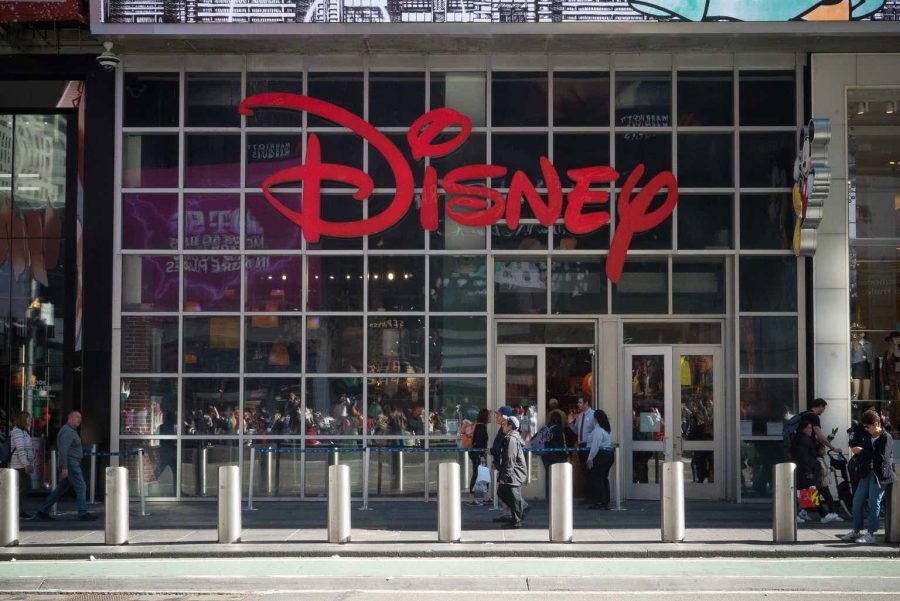Summary:
- Disney has faced challenges in recent years, including declining operating income and underperformance in its linear networks and streaming services.
- Despite these challenges, Disney’s Experiences segment, which includes parks and resorts, continues to show strong growth potential and profitability.
- Disney is focusing on profitability in its streaming services, with plans to bundle its DTC offerings and improve margins, leading to anticipated strong earnings growth in the future.
Massimo Giachetti/iStock Editorial via Getty Images
The following segment was excerpted from this fund letter.
The Walt Disney Company (NYSE:DIS)
Over the past decade, we have followed Disney with interest. It is a competitor to numerous stocks we’ve owned, including 21st Century Fox (which Disney purchased in 2019), Comcast (CMCSA) and Netflix (NFLX). We’ve always been impressed with their IP, and therefore were a bit surprised by the company’s underperformance over the last few years. Adjusted operating income declined from nearly $16b pre-pandemic to less than $13b in 2023, and the stock dropped by more than 50% from its 2021 peak.
Disney’s once-proud linear networks are now mired in secular decline. Its once-heralded streaming services have yet to turn a profit. Disney has faced numerous proxy battles with disgruntled shareholders. The firm has been trashed in the media, with headlines like “[CEO] Iger found Disney in worse shape than he expected.” It was also the near-unanimous pick for “Biggest Business Loser of 2023” from the hosts of the popular All-In podcast. Despite the headlines, we see a company with a tremendous business today, and a promise of more growth to come.
We believe Disney is undervalued because investors have fallen prey to availability bias: investors have focused on negative news headlines and challenges to prominent business lines rather than impartially evaluating the totality of the enterprise relative to its valuation. We think that at Disney’s current valuation, earnings at the Experiences segment can justify the entire market cap virtually by itself. Investors are getting the rest of the business – including Disney’s inimitable IP, growing streaming services nearing profitability, and shrinking but still profitable linear networks – at a steep discount.
Disney’s most profitable segment is Experiences, predominantly parks, resorts and cruises. Attendance, pricing, and margins have all grown consistently over the years, and in FY 2023 this business did $7b in operating income. This is up from $1b in 2004, which is a >10% CAGR. Very few businesses can sustain this sort of growth rate over 20 years and at this scale. This speaks to the unique nature of Disney’s parks, which integrate the world’s greatest entertainment IP with iconic rides and experiences. There is little direct competition.
The beauty is that they still have room to grow. Just in the last few months they added a “Zootopia” land and a “World of Frozen” land at the Shanghai and Hong Kong parks, respectively. Many more additions are planned over the next decade, partially filling the 1,000 acres the company owns adjacent to their current parks. As they put it in a press release, “Disney will explore even more characters and franchises, including some that haven’t been leveraged extensively to date, as it embarks on a new period of significant growth domestically and internationally in its parks and resorts.”
While their plans will consume capital – projected at $60b over the next ten years – we expect Disney to generate attractive returns on this investment, continuing to grow profits in the parks business at a 10% annual clip. By 2030, we expect the Experiences segment, which also includes consumer products, to generate $18b in annual EBIT, up from $9b in 2023.
The vast majority of Disney’s other revenue stems from the monetization of original video content: movies, TV shows, and sports broadcasting. Historically, Disney’s linear TV networks generated much of this revenue. But linear networks are now in decline as the world moves towards a streaming-first model. This has created upheaval at Disney, with its cable channels losing subscribers and cash-cow ESPN seeing a material decrease in profitability.
At the same time, Disney has attempted to unhitch itself from the doomed prospects of linear by investing heavily in streaming. Disney was late to the streaming game, launching their flagship Disney+ service a full 12 years after Netflix began streaming online. But the product is popular: Disney+ has 118m subscribers worldwide as of the end of Q1. At current run rates, it generates $10.3b in annual revenues.
To date, Disney’s streaming efforts (which also includes Hulu and ESPN+) have not been profitable. For a while, this was accepted by investors, as streaming was seen as a land grab with a very large pool of potential subscribers and profits down the road. And in the heady days of 2018 through 2021, few investors cared if your business was profitable if you were growing quickly. Disney prioritized rapid expansion of its streaming business, disregarding profitability in the process.
However, we have entered a new era. Netflix, Disney, and the other streamers are now laser-focused on margins, with Netflix guiding to record profit margins of 24% in 2024. Disney has pushed through large price increases in the ad-free Disney+ product, and forecasted a multi-billion dollar decline in content investment in 2024 as they focus on quality over quantity. While this combination might sound risky, we think that Disney’s evergreen content and still-attractive pricing – $8/mo for ad-supported and $14/mo for ad-free in the US – will continue to retain old customers and attract new ones. Other avenues for growth include growing its ad-supported tier and reducing password sharing.
Furthermore, we think Disney has a chance to greatly improve its DTC economics by bundling its disparate DTC services. Though the content bundle distributed by cable is dying a slow death, the bundling value proposition remains extremely attractive for consumers and producers alike. Bundling maximizes appeal and revenue, and reduces churn.
Disney is uniquely positioned to recreate their own in-house version of the cable bundle. Disney+ has inimitable specialty IP, including Disney Animation, Pixar, Star Wars, and Marvel. Hulu, soon to be wholly owned by Disney, has a wide selection of general entertainment content. In 2025, Disney will launch a flagship ESPN streaming service with ESPN’s full suite of content. With this content mix, Disney can create a compelling bundled offering for an enormous swath of consumers. Advertisers will love the one-stop shop for a large and diverse audience. We think this bundle will become an integral part of the entertainment package for hundreds of millions of households around the world.
Fundamentally, we believe that Disney’s content is extremely valuable. They have not been able to monetize this content effectively in a streaming-first world. Instead of profits, their valuable content has been generating huge losses, which has artificially depressed their earnings. We trust that with a newfound focus on profitability and an emphasis on rebundling, Disney will be able to find a revenue model that rewards them appropriately. Disney expects its combined streaming businesses to reach profitability in the third quarter and become a meaningful earnings growth driver from there on out. We anticipate Disney eventually generates at least 15% margins in its DTC business, swinging from a $2.5b operating loss in 2023 to a substantial profit within a few years.
The combination of losses in streaming, declines in cable subscribers, and escalating sports rights pricing has resulted in a significant decline in Disney’s profitability. However, with the Experiences segment alone justifying most of the current enterprise value, investors can acquire the rest of the business at a steep discount. We believe that DTC will generate strong earnings within a few years. The Sports and Linear Networks segments, though secularly challenged, will continue to generate substantial income in the near term, which is an added bonus.
We made a material investment in Disney in Q1 and today it is one of our largest positions.
|
Advisory fees and other important disclosures are described in Part 2 of Bireme’s Form ADV. Reported performance is a dollar-weighted average of the securities in the Fundamental Value L/S Model Portfolio maintained at Interactive Brokers from inception through October 2023. From November 2023 onward, reported performance is a dollar-weighted average of the performance of all client accounts invested solely in the Fundamental Value L/S strategy with no client-directed customizations to the portfolio composition. Performance is shown net of a 1% management fee and 10% performance fee. Available for Qualified Clients only as SEC rules do not permit performance fees for nonqualified investors. Past performance is not indicative of future results. Different types of investments involve varying degrees of risk and there can be no assurance that any specific investment will either be suitable or profitable for a client’s investment portfolio. The SPY ETF seeks to track the performance of the S&P 500 Index, and the performance described includes both fees and the reinvestment of dividends and other distributions. Registration does not constitute an endorsement of the firm, nor does it indicate that the advisor has attained a particular level of skill. See Disclaimer for important disclosures. Sources: Bloomberg Finance LP, Interactive Brokers LLC, S&P Compustat, Bireme Capital LLC. |
Editor’s Note: The summary bullets for this article were chosen by Seeking Alpha editors.
